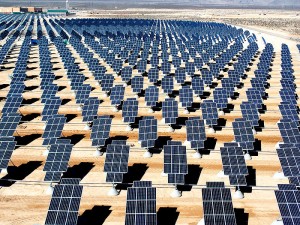Solar Photovoltaics Cells
 Continued from –Part I
Continued from –Part I
(This is a series of articles on the various technologies that can be employed to trap the sun’s energy. This is the 2nd part of the series.)
Solar PV (photovoltaics) converts sunlight directly into electricity by utilizing the photoelectric effect which is the knocking of electrons into a high energy state. Solar cells produce direct current electricity from light, which can be used to power equipment or to recharge a battery. When more power is needed, cells can be electrically connected together to form photovoltaic modules, or solar panels.
Materials used for making these cells are monocrystalline/ polycrystalline/ microcrystalline silicon, cadmium telluride, and copper indium selenide/sulfide. Silicon is preferred because it is easily available and also because of the huge technological base developed over the years in the semiconductor industry.
In case of a monocrystalline silicon, pure material is required and efficiency is high but it is also expensive; in polycrystalline type, liquid silicon is poured into shaped blocks which are then made into arrays, defect appears at borders so the resulting cell is less efficient but more cost effective; amorphous type is when a layer of silicon is deposited say on glass or other medium, efficiency is lowest here but cost is also very low. Amorphous type finds application in low power devices such as watches or calculators.
Silicon is very reflective, and this makes utilising sunlight a challenging affair. To overcome this, an antireflective coating (titanium dioxide or silicon nitride) is applied to the top of the cell to reduce reflection losses. This coating imparts the blue colour to solar cells instead of usual grey that silicon has.
Advantages:
- PV cells are comparatively light and have no moving parts and therefore require almost zero maintenance.
- They have a long life, high durability and low operating costs.
- A PV system can be constructed to virtually any size based on requirements. A user can easily add more if his requirements change.
Disadvantages:
- Some toxic chemicals, like cadmium and arsenic, are used in the PV production process. However, their environmental impacts are not significant and can be easily overridden if proper recycling and disposal is practiced.
- Solar panels need to be inclined at an angle as close to the area’s latitude as possible to absorb the maximum amount of energy year-round. Not every roof has the required orientation.
- Care should be taken to ensure that the cells are not shaded as the energy production is hampered.
Read Part 3 and Part 4
Know more about Solar PV technology here


In fact, we pay attention to safety in the use of solar panels as long as there should not be any problems.